There is a growing level of concerns towards oversupply by Chinese businesses in ‘PX (paraxylene)’ market that is one of main products of South Korea’s petrochemical industry.
According to petrochemical industry, average price of PX in May was $887.1 per ton that is 12.4% lower than that of April. Average monthly price of PX per ton has been dropping since February of this year.
Difference in prices of PX and naphtha, which is raw material of PX, also fell from $562.4 per ton earlier this year to $323.7 per ton in May. Petroleum chemistry industry usually sees break-even point of spread of PX at $250.
PX is raw material of terephthalic acid (PTA) that is used to make synthetic fiber and plastic bottle. In South Korea, it is produced by Hanwha Total (2 million tons), S-OIL (1.9 million tons), SK Incheon PetroChem (1.5 million tons), GS Caltex (1.35 million tons), Hyundai Cosmo (1.18 million tons), Ulsan Aromatics (1 million tons), SK Global Chemical (830,000 tons), and Lotte Chemical (750,000 tons).
Reason why PX market situation, which had shown a positive trend until last year, has suddenly gotten worse is because there are concerns about oversupply by Chinese businesses. While PX production plants are expected to expand by 30% for the next three years centered on China, demands are expected to remain between 4 and 5% at the maximum annually.

Extension of PX plants that are responsible for 16.6 million tons of PX are scheduled in China until 2021. Extension project by Hengli Petrochemical especially draws most attentions. Hengli is China’s biggest polyester manufacturer and it has been pushing for construction project of large-scale petrochemical complex since end of 2015 for vertical integration. Extension of PX plants that are able to produce 4.5 million tons of PX annually is one of Hengli’s major projects.
“After visiting China recently, Hengli finished mechanical part of construction of its PX plant and it is currently selling prototypes of PX sparingly.” said Hwang Yoo-shik of NH Securities. “4.5 million tons of PX corresponds to 35% of entire PX plants in China at the end of 2018 and 8% of entire PX plants in the world and it will be difficult for PX price to rebound once Hengli starts producing this amount.”
If PX self-sufficiency by China businesses increases, this can lead to reduction in exportation of PX by South Korean businesses. PX is responsible for 37% of entire petrochemical products that are exported to China. Although Chinese businesses started to import more PX as they started to produce PTA more, amount of exportation of PX will decrease once Chinese businesses become more self-sufficient on PX.
It seems that major suppliers are going to either push forward planned maintenance schedule or reduce amount of supplies by adjusting operation rate to deal with this current trend.
“Downward trend started for PX market as Chinese businesses have begun to start operating their large-scale PX plants.” said Lee Dong-wook of Kiwoom Securities. “Global PX operation rate that exceeded 85% in 2018 will fall below of 85% this year and it is expected to drop to about 75% in 2020.”
Staff Reporter Jung, Hyunjung | iam@etnews.com